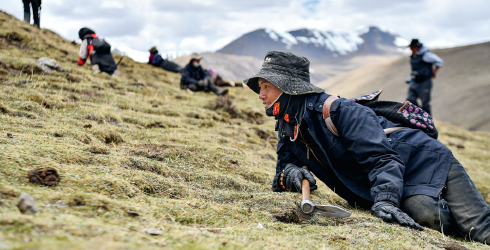Medicinal herb is a healthy harvest

Cordyceps sinensis is a tonic herb, known as "soft gold" in the Tibet autonomous region. It is mainly distributed in the Qinghai-Tibet Plateau at an altitude of 3,500 to 5,000 meters. The harvesting season in Tibet started in late May.
Nagqu is the "north gate" of Tibet, with an average altitude of more than 4,500 meters. Its sunshine, timely monsoons and snow provide the best conditions for the reproduction of cordyceps. The city's Biru county is one of the most famous and productive areas for growing cordyceps. Here it takes on a light brown color, which suggests higher doses of adenosine.
Donning masks, gloves and hats, the herdsmen have to crawl on the grass to spot the herb. Normally, herdsmen spend at least one hour after going up the mountain to find their first cordyceps. They climb along the steep hillside to an altitude of more than 4,700 meters to the meadow where cordyceps seems to hide. With one leg bent, the other straight, elbows against the turf, herdsmen look for this particular brown bud.
Once the herb is spotted, they first measure the distance with their hands, then take out a hoe the size of a palm, raise a small piece of turf around the cordyceps, carefully remove the herb, and fill the turf back in place. The purpose of measuring the distance is to prevent the cordyceps from being cut off, and backfilling the turf is to protect the environment, so that the grass on the surface can continue to grow.
Harvesting cordyceps is an important source of income for many local herdsmen. Just like in previous years, herdsmen gather at the cordyceps collection site in Ranmutang village. They open their arms to accept nature's gifts from the snow-covered plateau.
Xiao Yong, deputy director of the Grassland Management Office of the Forestry and Grassland Administration in Tibet, says the harvesting season for cordyceps is from around April 20 to the end of July every year.
According to Chinese medicine literature, it is sweet in taste and warm in nature, and has the functions of nourishing the lungs and invigorating the kidneys. It is recognized as one of the "three great supplements", along with ginseng and deer antler. There are 507 species of cordyceps in the world, of which only one can be called Cordyceps sinensis, while the remaining 506 species are general cordyceps.
Under normal circumstances, there are more than 1,000 cords of cordyceps per pound-the fewer the number of cords, the better the quality and the higher the price.
Cordyceps is produced by the combination of insects and fungi. The winter worm is 3 to 5 cm long with eight pairs of gastropods. The summer grass is shaped like a baseball bat, 4 to 11 cm long, dark brown on the surface, white when broken. Cordyceps fungus invades the larvae of the cordyceps bat moth in winter, absorbs nutrients, and develops mycelium. In summer, the fungus grows from the top of the dead insect's head, popping out of the soil surface, hence it is also called "summer grass". Cordyceps contains about 7 percent of oxalic acid (mannitol), about 25 percent protein, and 8.4 percent fat.
Cordyceps is thus sought after by many well-off families. Strong market demand has caused prices to soar every year. High-quality cordyceps can sell for more than 100,000 yuan ($14,980) per pound.
The setting sun stretches out the shadows on their way back, and the herdsmen return to their tents with the cordyceps they have dug up. The solar panels standing beside the tent lit up the valley, and the raindrops hit the tent, like a peaceful nocturne.



































